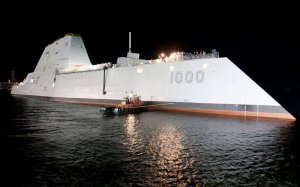Can the Navy’s $12 Billion Stealth Destroyer Stay Afloat?
 The vessel—which is the largest American surface warship since the 1950s–brings a new untried “tumblehome” hull design, new power systems and gun technology that have not been used on a modern warship before. The ship is highly automated with a crew of just 142 — compared to older ships that have a complement of about 300. But despite its massive size, the stealthy warship appears on an enemy’s sensors as something no larger than a small fishing boat.
The vessel—which is the largest American surface warship since the 1950s–brings a new untried “tumblehome” hull design, new power systems and gun technology that have not been used on a modern warship before. The ship is highly automated with a crew of just 142 — compared to older ships that have a complement of about 300. But despite its massive size, the stealthy warship appears on an enemy’s sensors as something no larger than a small fishing boat.The 600-foot long ship is armed with 80 missiles tubes, two massive 155mm guns that can lob guided shells 80 miles away and a pair of 30mm guns for self-defense. Theoretically, the ship can take on all comers in the air, sea, underwater or on land. In the future, the ship could be fitted with futuristic lasers and electro-magnetic rail-guns too. Additionally, the so-called DDG-1000 can also carry either a pair of helicopters or a single helicopter and a trio of drones.
But it all comes at a steep price—the first two ships cost $4.2 billion dollars each while the third costs $3.5 billion. The DDG-1000 is so expensive—and there are so many doubts about its technology—that the Navy is building only three of the ships before in favor of buying an improved version of its older Arleigh Burke-class destroyer.
One those doubts includes a potential Achilles’ heel –the ship’s bizarre stealthy hull—which is the most obvious new feature of the new destroyer. The hull looks like it is upside down. Unlike a normal ship, the bow slopes upward from the water up to the deck. Meanwhile, the rest of hull is wide at the waterline and slopes inward. If one were to look at the ship directly from the front, it would resemble a bell rather than the traditional “flared hull” with a V or U shape that is most common. There have been persistent concerns about how stable the tumblehome design is in any sort of rough seas—in fact, one of the concerns about the design is that it could capsize if it is hit by a large wave from the wrong angle. “This is an area that the Navy is taking seriously,” one naval architect familiar with the design told The Daily Beast.
